Business Ethics: A Case Study on Hutong Enterprises
VerifiedAdded on 2023/06/04
|18
|4986
|477
AI Summary
This article examines the ethical and moral issues arising from the challenges facing Hutong Enterprises, a technological equipment manufacturer. It explores the contradictions between the company's espoused culture and its recent actions, and offers advice on future approaches to issues within the organization.
Contribute Materials
Your contribution can guide someone’s learning journey. Share your
documents today.
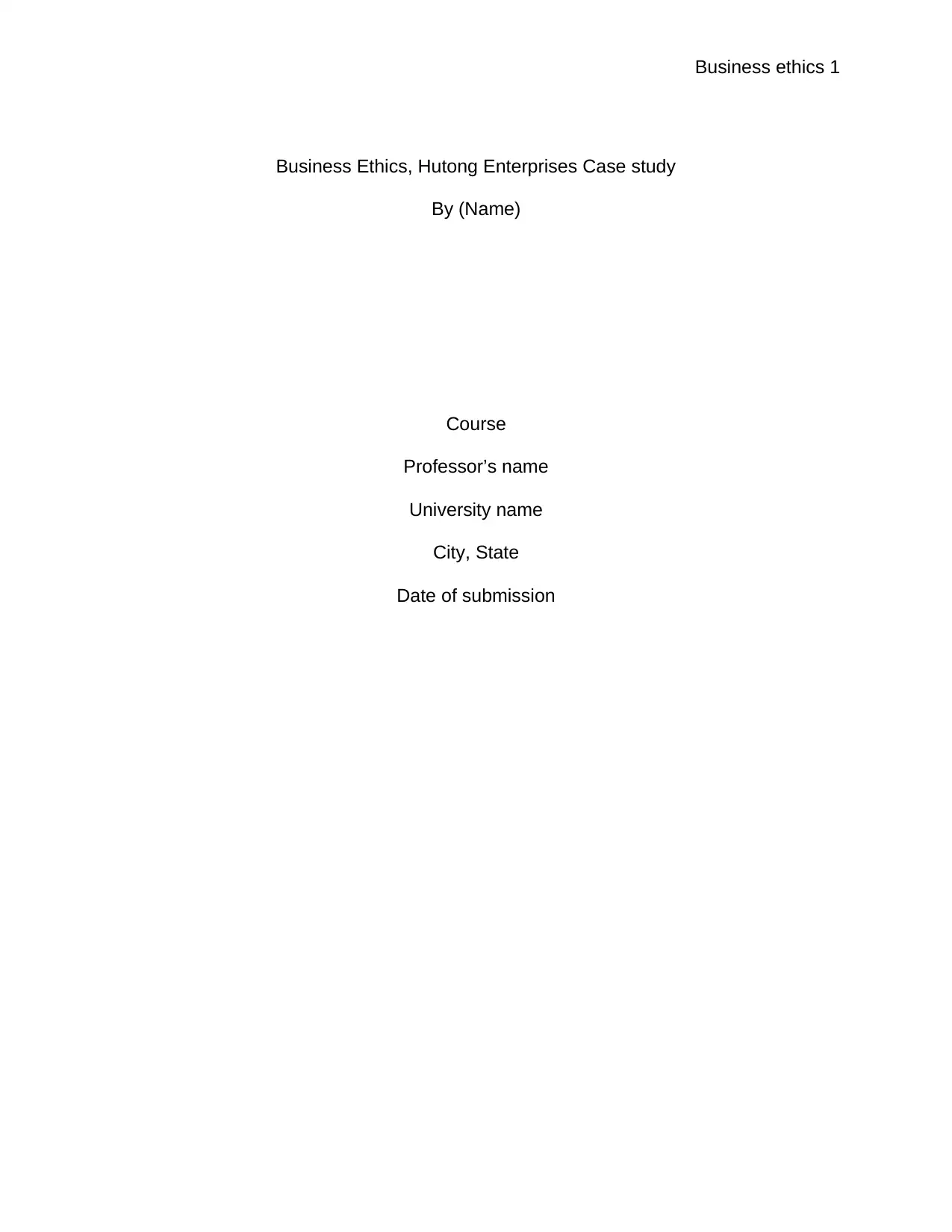
Business ethics 1
Business Ethics, Hutong Enterprises Case study
By (Name)
Course
Professor’s name
University name
City, State
Date of submission
Business Ethics, Hutong Enterprises Case study
By (Name)
Course
Professor’s name
University name
City, State
Date of submission
Secure Best Marks with AI Grader
Need help grading? Try our AI Grader for instant feedback on your assignments.

Business ethics 2
Acknowledgements
This article would not be possible without help from various stakeholders who
offered informative input and advice. Special thanks to the University head of the
business department, school librarian and classmates who contributed their knowledge
and guidance in the course of writing this document. All your efforts are sincerely
appreciated
Acknowledgements
This article would not be possible without help from various stakeholders who
offered informative input and advice. Special thanks to the University head of the
business department, school librarian and classmates who contributed their knowledge
and guidance in the course of writing this document. All your efforts are sincerely
appreciated
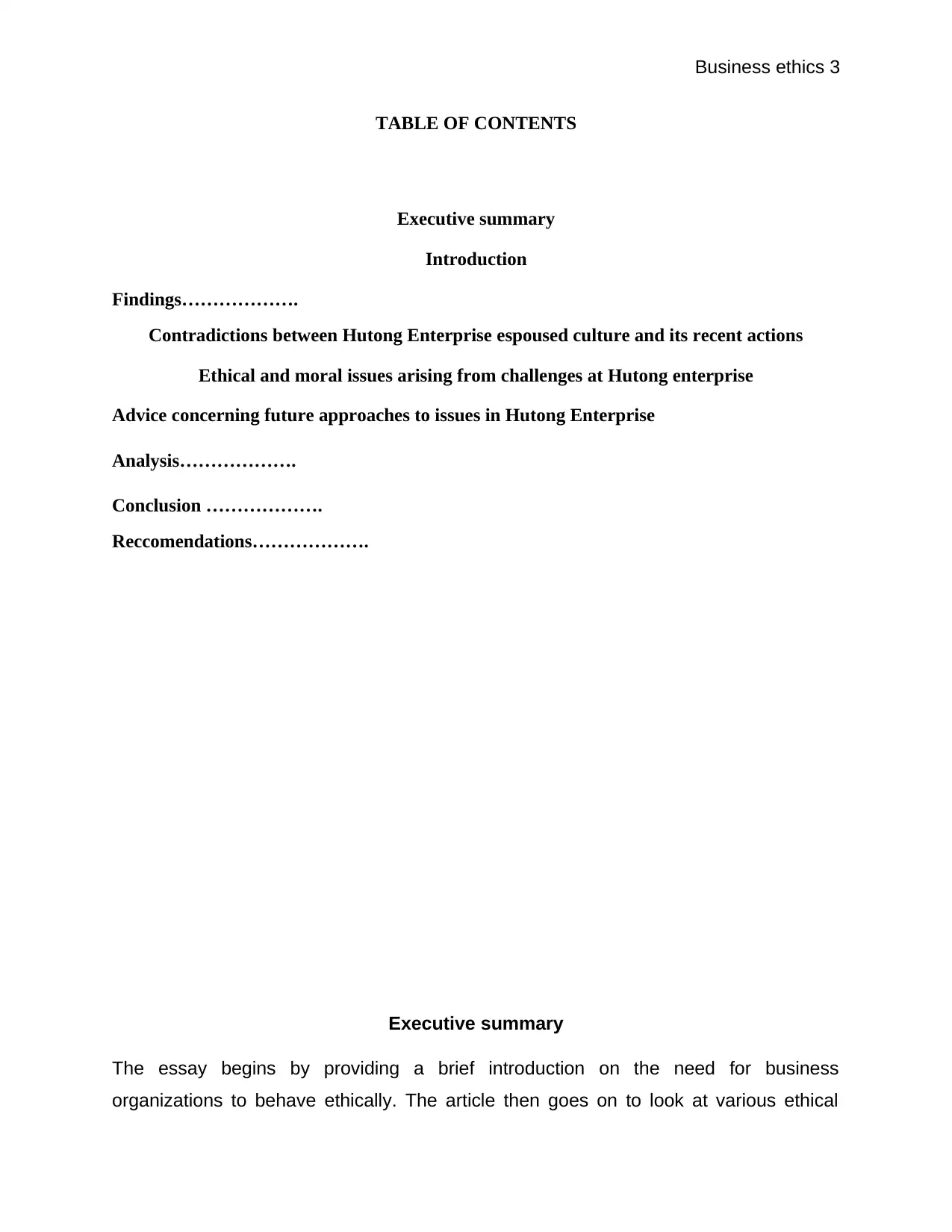
Business ethics 3
TABLE OF CONTENTS
Executive summary
Introduction
Findings……………….
Contradictions between Hutong Enterprise espoused culture and its recent actions
Ethical and moral issues arising from challenges at Hutong enterprise
Advice concerning future approaches to issues in Hutong Enterprise
Analysis……………….
Conclusion ……………….
Reccomendations……………….
Executive summary
The essay begins by providing a brief introduction on the need for business
organizations to behave ethically. The article then goes on to look at various ethical
TABLE OF CONTENTS
Executive summary
Introduction
Findings……………….
Contradictions between Hutong Enterprise espoused culture and its recent actions
Ethical and moral issues arising from challenges at Hutong enterprise
Advice concerning future approaches to issues in Hutong Enterprise
Analysis……………….
Conclusion ……………….
Reccomendations……………….
Executive summary
The essay begins by providing a brief introduction on the need for business
organizations to behave ethically. The article then goes on to look at various ethical

Business ethics 4
aspects relating to Hutong Enterprise (HE) which is the subject of the case study. First,
the essay examines the multiple contradictions that exist between HE’s espoused
culture and its recent actions. In this segment, the also explores the different reasons
that can cause a business organization to act contrary to its values and established
regulations regarding the labor rights of employees. Afterward,the essay offers various
measures that a business organization can put in place to ensure compliance with its
values and relevant regulations. In the third segment, the paper uses multiple theories
to explore the moral and ethical issues that HE faces as a result of its extreme labor
policies that adversely affect the welfare of employees. Afterward,the article looks at the
various ways in which Hutong Enterprises can achieve its business objectives without
curtailing the rights of its employees. Additionally, the essay provides ways suggestions
on how Hutong Enterprise can handle time-related issues if and when they occur
Introduction
Business ethics outlines the regulations within which business organizations
should operate. Business ethics are meant to ensure that firms and companies relate
aspects relating to Hutong Enterprise (HE) which is the subject of the case study. First,
the essay examines the multiple contradictions that exist between HE’s espoused
culture and its recent actions. In this segment, the also explores the different reasons
that can cause a business organization to act contrary to its values and established
regulations regarding the labor rights of employees. Afterward,the essay offers various
measures that a business organization can put in place to ensure compliance with its
values and relevant regulations. In the third segment, the paper uses multiple theories
to explore the moral and ethical issues that HE faces as a result of its extreme labor
policies that adversely affect the welfare of employees. Afterward,the article looks at the
various ways in which Hutong Enterprises can achieve its business objectives without
curtailing the rights of its employees. Additionally, the essay provides ways suggestions
on how Hutong Enterprise can handle time-related issues if and when they occur
Introduction
Business ethics outlines the regulations within which business organizations
should operate. Business ethics are meant to ensure that firms and companies relate
Secure Best Marks with AI Grader
Need help grading? Try our AI Grader for instant feedback on your assignments.
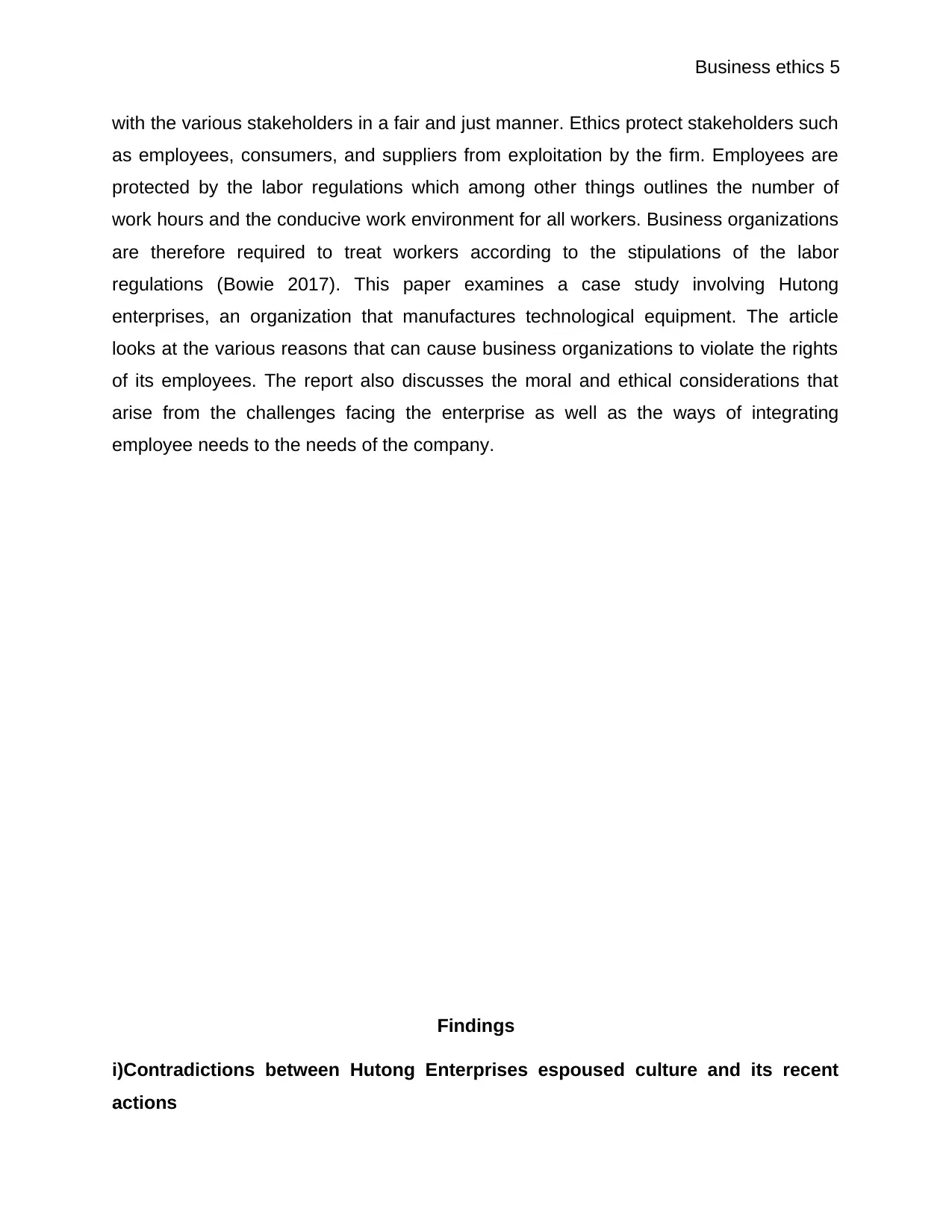
Business ethics 5
with the various stakeholders in a fair and just manner. Ethics protect stakeholders such
as employees, consumers, and suppliers from exploitation by the firm. Employees are
protected by the labor regulations which among other things outlines the number of
work hours and the conducive work environment for all workers. Business organizations
are therefore required to treat workers according to the stipulations of the labor
regulations (Bowie 2017). This paper examines a case study involving Hutong
enterprises, an organization that manufactures technological equipment. The article
looks at the various reasons that can cause business organizations to violate the rights
of its employees. The report also discusses the moral and ethical considerations that
arise from the challenges facing the enterprise as well as the ways of integrating
employee needs to the needs of the company.
Findings
i)Contradictions between Hutong Enterprises espoused culture and its recent
actions
with the various stakeholders in a fair and just manner. Ethics protect stakeholders such
as employees, consumers, and suppliers from exploitation by the firm. Employees are
protected by the labor regulations which among other things outlines the number of
work hours and the conducive work environment for all workers. Business organizations
are therefore required to treat workers according to the stipulations of the labor
regulations (Bowie 2017). This paper examines a case study involving Hutong
enterprises, an organization that manufactures technological equipment. The article
looks at the various reasons that can cause business organizations to violate the rights
of its employees. The report also discusses the moral and ethical considerations that
arise from the challenges facing the enterprise as well as the ways of integrating
employee needs to the needs of the company.
Findings
i)Contradictions between Hutong Enterprises espoused culture and its recent
actions
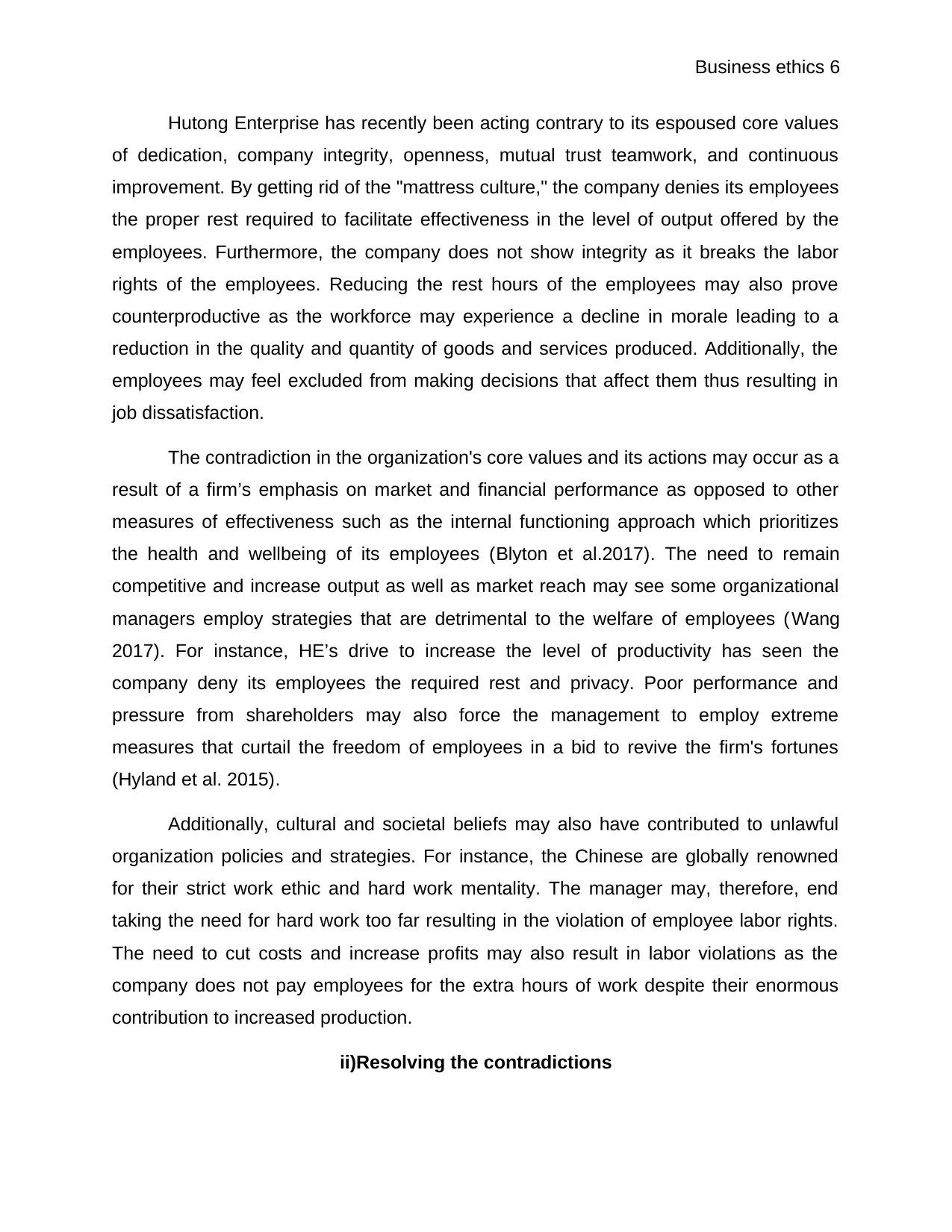
Business ethics 6
Hutong Enterprise has recently been acting contrary to its espoused core values
of dedication, company integrity, openness, mutual trust teamwork, and continuous
improvement. By getting rid of the "mattress culture," the company denies its employees
the proper rest required to facilitate effectiveness in the level of output offered by the
employees. Furthermore, the company does not show integrity as it breaks the labor
rights of the employees. Reducing the rest hours of the employees may also prove
counterproductive as the workforce may experience a decline in morale leading to a
reduction in the quality and quantity of goods and services produced. Additionally, the
employees may feel excluded from making decisions that affect them thus resulting in
job dissatisfaction.
The contradiction in the organization's core values and its actions may occur as a
result of a firm’s emphasis on market and financial performance as opposed to other
measures of effectiveness such as the internal functioning approach which prioritizes
the health and wellbeing of its employees (Blyton et al.2017). The need to remain
competitive and increase output as well as market reach may see some organizational
managers employ strategies that are detrimental to the welfare of employees (Wang
2017). For instance, HE’s drive to increase the level of productivity has seen the
company deny its employees the required rest and privacy. Poor performance and
pressure from shareholders may also force the management to employ extreme
measures that curtail the freedom of employees in a bid to revive the firm's fortunes
(Hyland et al. 2015).
Additionally, cultural and societal beliefs may also have contributed to unlawful
organization policies and strategies. For instance, the Chinese are globally renowned
for their strict work ethic and hard work mentality. The manager may, therefore, end
taking the need for hard work too far resulting in the violation of employee labor rights.
The need to cut costs and increase profits may also result in labor violations as the
company does not pay employees for the extra hours of work despite their enormous
contribution to increased production.
ii)Resolving the contradictions
Hutong Enterprise has recently been acting contrary to its espoused core values
of dedication, company integrity, openness, mutual trust teamwork, and continuous
improvement. By getting rid of the "mattress culture," the company denies its employees
the proper rest required to facilitate effectiveness in the level of output offered by the
employees. Furthermore, the company does not show integrity as it breaks the labor
rights of the employees. Reducing the rest hours of the employees may also prove
counterproductive as the workforce may experience a decline in morale leading to a
reduction in the quality and quantity of goods and services produced. Additionally, the
employees may feel excluded from making decisions that affect them thus resulting in
job dissatisfaction.
The contradiction in the organization's core values and its actions may occur as a
result of a firm’s emphasis on market and financial performance as opposed to other
measures of effectiveness such as the internal functioning approach which prioritizes
the health and wellbeing of its employees (Blyton et al.2017). The need to remain
competitive and increase output as well as market reach may see some organizational
managers employ strategies that are detrimental to the welfare of employees (Wang
2017). For instance, HE’s drive to increase the level of productivity has seen the
company deny its employees the required rest and privacy. Poor performance and
pressure from shareholders may also force the management to employ extreme
measures that curtail the freedom of employees in a bid to revive the firm's fortunes
(Hyland et al. 2015).
Additionally, cultural and societal beliefs may also have contributed to unlawful
organization policies and strategies. For instance, the Chinese are globally renowned
for their strict work ethic and hard work mentality. The manager may, therefore, end
taking the need for hard work too far resulting in the violation of employee labor rights.
The need to cut costs and increase profits may also result in labor violations as the
company does not pay employees for the extra hours of work despite their enormous
contribution to increased production.
ii)Resolving the contradictions
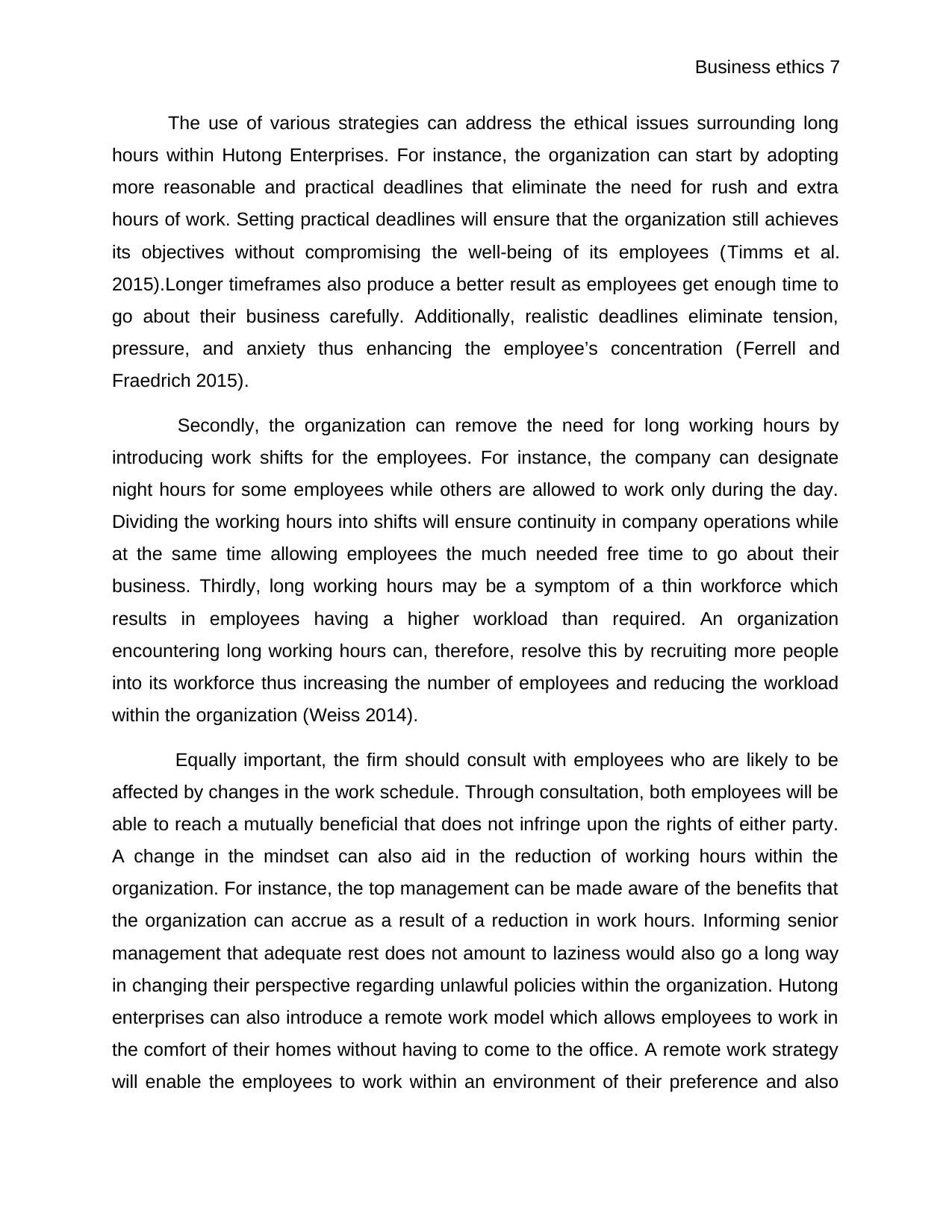
Business ethics 7
The use of various strategies can address the ethical issues surrounding long
hours within Hutong Enterprises. For instance, the organization can start by adopting
more reasonable and practical deadlines that eliminate the need for rush and extra
hours of work. Setting practical deadlines will ensure that the organization still achieves
its objectives without compromising the well-being of its employees (Timms et al.
2015).Longer timeframes also produce a better result as employees get enough time to
go about their business carefully. Additionally, realistic deadlines eliminate tension,
pressure, and anxiety thus enhancing the employee’s concentration (Ferrell and
Fraedrich 2015).
Secondly, the organization can remove the need for long working hours by
introducing work shifts for the employees. For instance, the company can designate
night hours for some employees while others are allowed to work only during the day.
Dividing the working hours into shifts will ensure continuity in company operations while
at the same time allowing employees the much needed free time to go about their
business. Thirdly, long working hours may be a symptom of a thin workforce which
results in employees having a higher workload than required. An organization
encountering long working hours can, therefore, resolve this by recruiting more people
into its workforce thus increasing the number of employees and reducing the workload
within the organization (Weiss 2014).
Equally important, the firm should consult with employees who are likely to be
affected by changes in the work schedule. Through consultation, both employees will be
able to reach a mutually beneficial that does not infringe upon the rights of either party.
A change in the mindset can also aid in the reduction of working hours within the
organization. For instance, the top management can be made aware of the benefits that
the organization can accrue as a result of a reduction in work hours. Informing senior
management that adequate rest does not amount to laziness would also go a long way
in changing their perspective regarding unlawful policies within the organization. Hutong
enterprises can also introduce a remote work model which allows employees to work in
the comfort of their homes without having to come to the office. A remote work strategy
will enable the employees to work within an environment of their preference and also
The use of various strategies can address the ethical issues surrounding long
hours within Hutong Enterprises. For instance, the organization can start by adopting
more reasonable and practical deadlines that eliminate the need for rush and extra
hours of work. Setting practical deadlines will ensure that the organization still achieves
its objectives without compromising the well-being of its employees (Timms et al.
2015).Longer timeframes also produce a better result as employees get enough time to
go about their business carefully. Additionally, realistic deadlines eliminate tension,
pressure, and anxiety thus enhancing the employee’s concentration (Ferrell and
Fraedrich 2015).
Secondly, the organization can remove the need for long working hours by
introducing work shifts for the employees. For instance, the company can designate
night hours for some employees while others are allowed to work only during the day.
Dividing the working hours into shifts will ensure continuity in company operations while
at the same time allowing employees the much needed free time to go about their
business. Thirdly, long working hours may be a symptom of a thin workforce which
results in employees having a higher workload than required. An organization
encountering long working hours can, therefore, resolve this by recruiting more people
into its workforce thus increasing the number of employees and reducing the workload
within the organization (Weiss 2014).
Equally important, the firm should consult with employees who are likely to be
affected by changes in the work schedule. Through consultation, both employees will be
able to reach a mutually beneficial that does not infringe upon the rights of either party.
A change in the mindset can also aid in the reduction of working hours within the
organization. For instance, the top management can be made aware of the benefits that
the organization can accrue as a result of a reduction in work hours. Informing senior
management that adequate rest does not amount to laziness would also go a long way
in changing their perspective regarding unlawful policies within the organization. Hutong
enterprises can also introduce a remote work model which allows employees to work in
the comfort of their homes without having to come to the office. A remote work strategy
will enable the employees to work within an environment of their preference and also
Paraphrase This Document
Need a fresh take? Get an instant paraphrase of this document with our AI Paraphraser
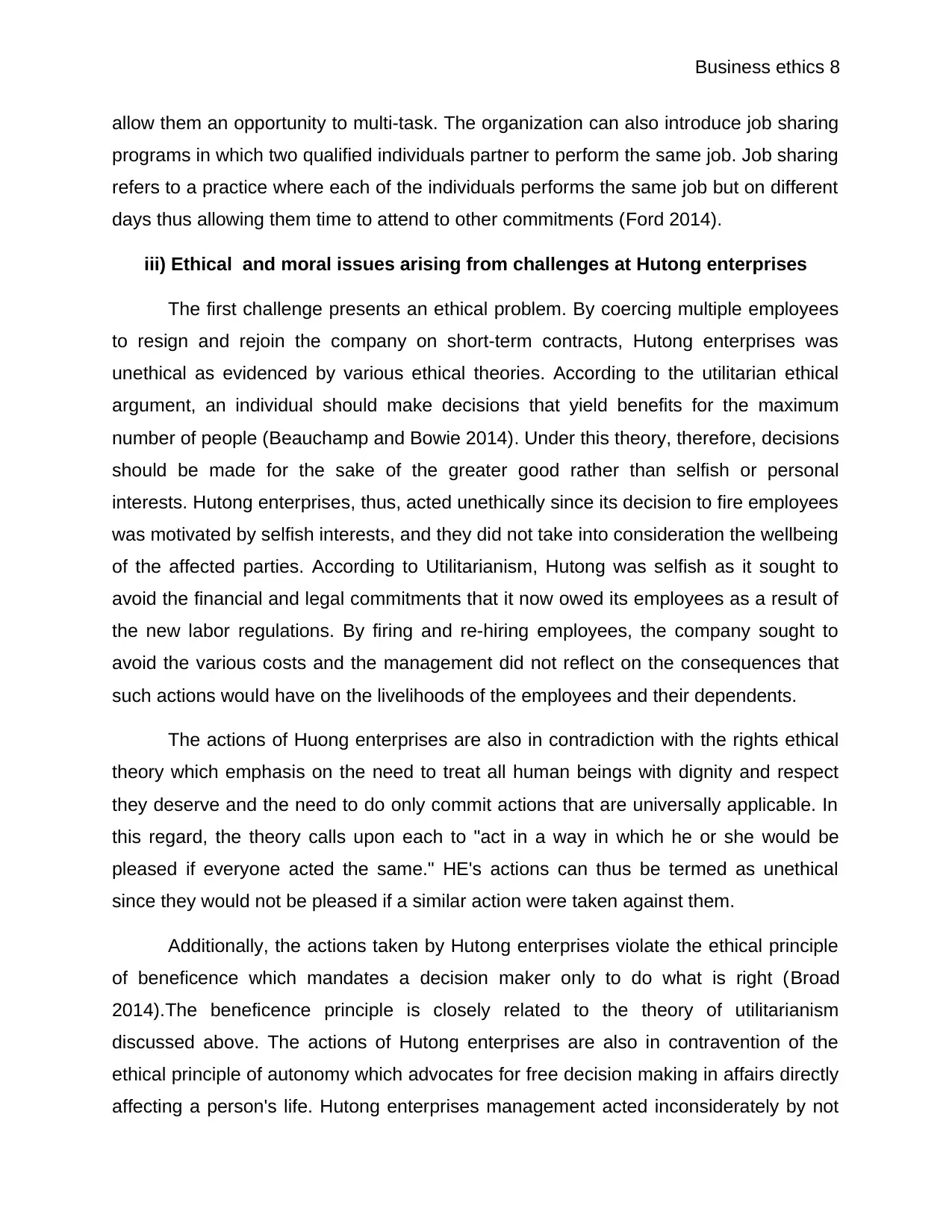
Business ethics 8
allow them an opportunity to multi-task. The organization can also introduce job sharing
programs in which two qualified individuals partner to perform the same job. Job sharing
refers to a practice where each of the individuals performs the same job but on different
days thus allowing them time to attend to other commitments (Ford 2014).
iii) Ethical and moral issues arising from challenges at Hutong enterprises
The first challenge presents an ethical problem. By coercing multiple employees
to resign and rejoin the company on short-term contracts, Hutong enterprises was
unethical as evidenced by various ethical theories. According to the utilitarian ethical
argument, an individual should make decisions that yield benefits for the maximum
number of people (Beauchamp and Bowie 2014). Under this theory, therefore, decisions
should be made for the sake of the greater good rather than selfish or personal
interests. Hutong enterprises, thus, acted unethically since its decision to fire employees
was motivated by selfish interests, and they did not take into consideration the wellbeing
of the affected parties. According to Utilitarianism, Hutong was selfish as it sought to
avoid the financial and legal commitments that it now owed its employees as a result of
the new labor regulations. By firing and re-hiring employees, the company sought to
avoid the various costs and the management did not reflect on the consequences that
such actions would have on the livelihoods of the employees and their dependents.
The actions of Huong enterprises are also in contradiction with the rights ethical
theory which emphasis on the need to treat all human beings with dignity and respect
they deserve and the need to do only commit actions that are universally applicable. In
this regard, the theory calls upon each to "act in a way in which he or she would be
pleased if everyone acted the same." HE's actions can thus be termed as unethical
since they would not be pleased if a similar action were taken against them.
Additionally, the actions taken by Hutong enterprises violate the ethical principle
of beneficence which mandates a decision maker only to do what is right (Broad
2014).The beneficence principle is closely related to the theory of utilitarianism
discussed above. The actions of Hutong enterprises are also in contravention of the
ethical principle of autonomy which advocates for free decision making in affairs directly
affecting a person's life. Hutong enterprises management acted inconsiderately by not
allow them an opportunity to multi-task. The organization can also introduce job sharing
programs in which two qualified individuals partner to perform the same job. Job sharing
refers to a practice where each of the individuals performs the same job but on different
days thus allowing them time to attend to other commitments (Ford 2014).
iii) Ethical and moral issues arising from challenges at Hutong enterprises
The first challenge presents an ethical problem. By coercing multiple employees
to resign and rejoin the company on short-term contracts, Hutong enterprises was
unethical as evidenced by various ethical theories. According to the utilitarian ethical
argument, an individual should make decisions that yield benefits for the maximum
number of people (Beauchamp and Bowie 2014). Under this theory, therefore, decisions
should be made for the sake of the greater good rather than selfish or personal
interests. Hutong enterprises, thus, acted unethically since its decision to fire employees
was motivated by selfish interests, and they did not take into consideration the wellbeing
of the affected parties. According to Utilitarianism, Hutong was selfish as it sought to
avoid the financial and legal commitments that it now owed its employees as a result of
the new labor regulations. By firing and re-hiring employees, the company sought to
avoid the various costs and the management did not reflect on the consequences that
such actions would have on the livelihoods of the employees and their dependents.
The actions of Huong enterprises are also in contradiction with the rights ethical
theory which emphasis on the need to treat all human beings with dignity and respect
they deserve and the need to do only commit actions that are universally applicable. In
this regard, the theory calls upon each to "act in a way in which he or she would be
pleased if everyone acted the same." HE's actions can thus be termed as unethical
since they would not be pleased if a similar action were taken against them.
Additionally, the actions taken by Hutong enterprises violate the ethical principle
of beneficence which mandates a decision maker only to do what is right (Broad
2014).The beneficence principle is closely related to the theory of utilitarianism
discussed above. The actions of Hutong enterprises are also in contravention of the
ethical principle of autonomy which advocates for free decision making in affairs directly
affecting a person's life. Hutong enterprises management acted inconsiderately by not
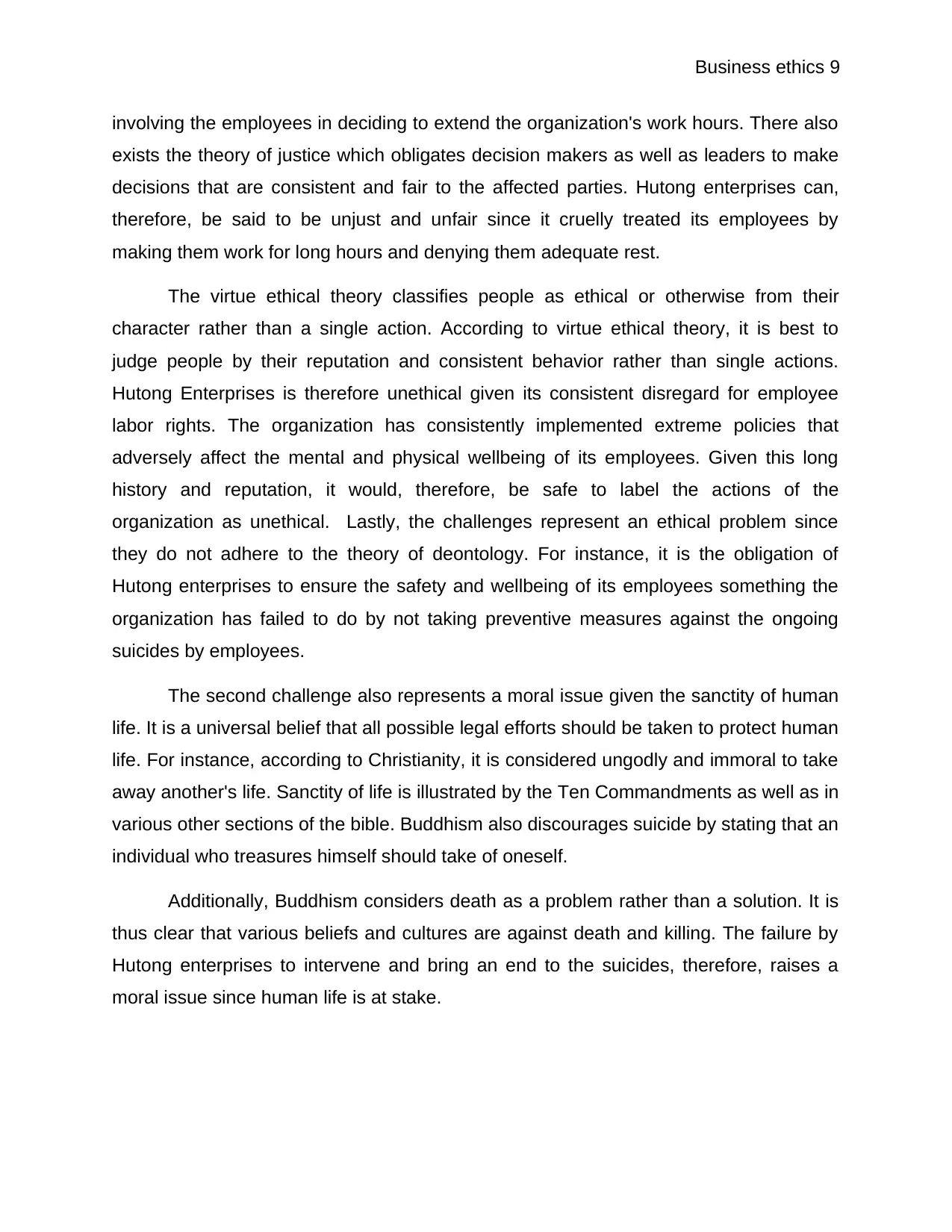
Business ethics 9
involving the employees in deciding to extend the organization's work hours. There also
exists the theory of justice which obligates decision makers as well as leaders to make
decisions that are consistent and fair to the affected parties. Hutong enterprises can,
therefore, be said to be unjust and unfair since it cruelly treated its employees by
making them work for long hours and denying them adequate rest.
The virtue ethical theory classifies people as ethical or otherwise from their
character rather than a single action. According to virtue ethical theory, it is best to
judge people by their reputation and consistent behavior rather than single actions.
Hutong Enterprises is therefore unethical given its consistent disregard for employee
labor rights. The organization has consistently implemented extreme policies that
adversely affect the mental and physical wellbeing of its employees. Given this long
history and reputation, it would, therefore, be safe to label the actions of the
organization as unethical. Lastly, the challenges represent an ethical problem since
they do not adhere to the theory of deontology. For instance, it is the obligation of
Hutong enterprises to ensure the safety and wellbeing of its employees something the
organization has failed to do by not taking preventive measures against the ongoing
suicides by employees.
The second challenge also represents a moral issue given the sanctity of human
life. It is a universal belief that all possible legal efforts should be taken to protect human
life. For instance, according to Christianity, it is considered ungodly and immoral to take
away another's life. Sanctity of life is illustrated by the Ten Commandments as well as in
various other sections of the bible. Buddhism also discourages suicide by stating that an
individual who treasures himself should take of oneself.
Additionally, Buddhism considers death as a problem rather than a solution. It is
thus clear that various beliefs and cultures are against death and killing. The failure by
Hutong enterprises to intervene and bring an end to the suicides, therefore, raises a
moral issue since human life is at stake.
involving the employees in deciding to extend the organization's work hours. There also
exists the theory of justice which obligates decision makers as well as leaders to make
decisions that are consistent and fair to the affected parties. Hutong enterprises can,
therefore, be said to be unjust and unfair since it cruelly treated its employees by
making them work for long hours and denying them adequate rest.
The virtue ethical theory classifies people as ethical or otherwise from their
character rather than a single action. According to virtue ethical theory, it is best to
judge people by their reputation and consistent behavior rather than single actions.
Hutong Enterprises is therefore unethical given its consistent disregard for employee
labor rights. The organization has consistently implemented extreme policies that
adversely affect the mental and physical wellbeing of its employees. Given this long
history and reputation, it would, therefore, be safe to label the actions of the
organization as unethical. Lastly, the challenges represent an ethical problem since
they do not adhere to the theory of deontology. For instance, it is the obligation of
Hutong enterprises to ensure the safety and wellbeing of its employees something the
organization has failed to do by not taking preventive measures against the ongoing
suicides by employees.
The second challenge also represents a moral issue given the sanctity of human
life. It is a universal belief that all possible legal efforts should be taken to protect human
life. For instance, according to Christianity, it is considered ungodly and immoral to take
away another's life. Sanctity of life is illustrated by the Ten Commandments as well as in
various other sections of the bible. Buddhism also discourages suicide by stating that an
individual who treasures himself should take of oneself.
Additionally, Buddhism considers death as a problem rather than a solution. It is
thus clear that various beliefs and cultures are against death and killing. The failure by
Hutong enterprises to intervene and bring an end to the suicides, therefore, raises a
moral issue since human life is at stake.
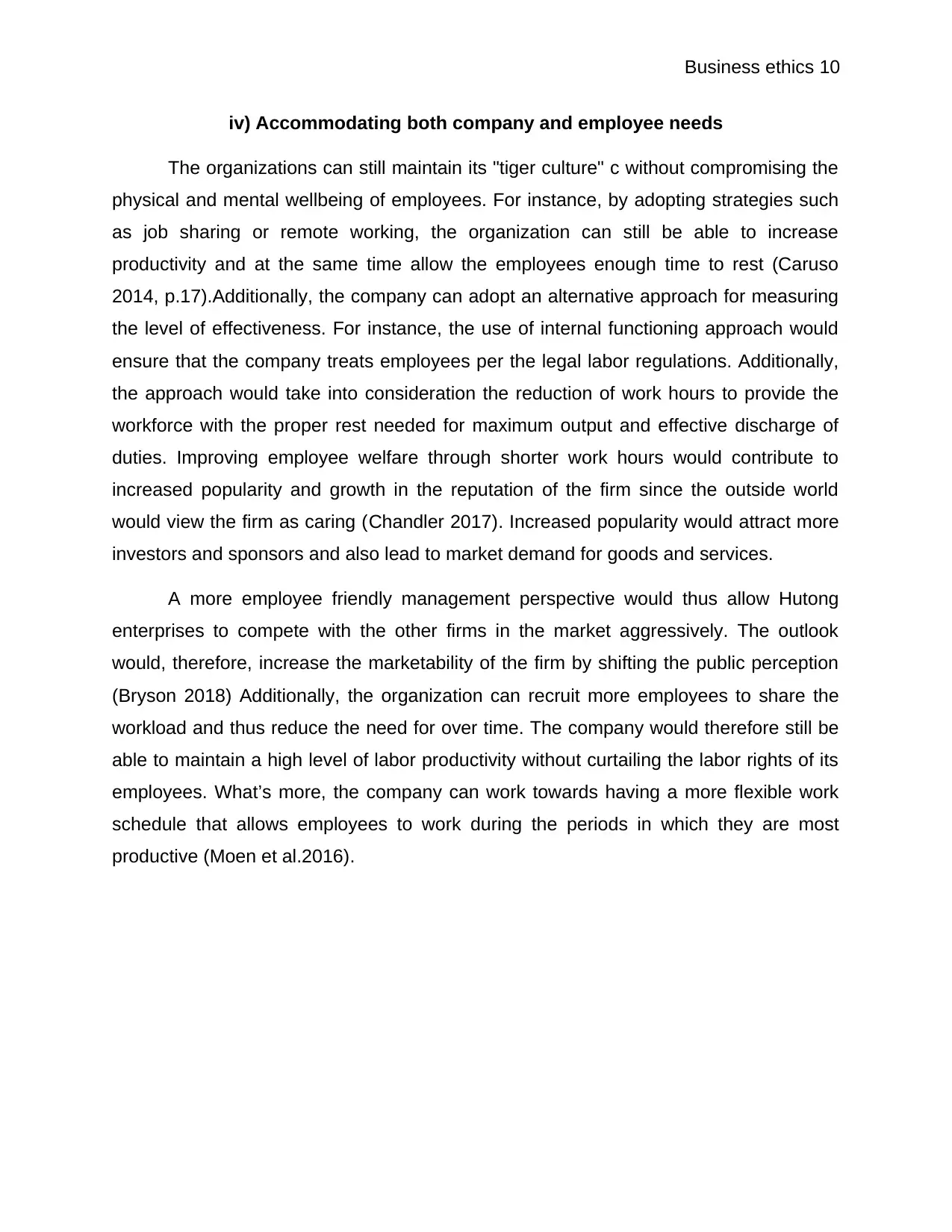
Business ethics 10
iv) Accommodating both company and employee needs
The organizations can still maintain its "tiger culture" c without compromising the
physical and mental wellbeing of employees. For instance, by adopting strategies such
as job sharing or remote working, the organization can still be able to increase
productivity and at the same time allow the employees enough time to rest (Caruso
2014, p.17).Additionally, the company can adopt an alternative approach for measuring
the level of effectiveness. For instance, the use of internal functioning approach would
ensure that the company treats employees per the legal labor regulations. Additionally,
the approach would take into consideration the reduction of work hours to provide the
workforce with the proper rest needed for maximum output and effective discharge of
duties. Improving employee welfare through shorter work hours would contribute to
increased popularity and growth in the reputation of the firm since the outside world
would view the firm as caring (Chandler 2017). Increased popularity would attract more
investors and sponsors and also lead to market demand for goods and services.
A more employee friendly management perspective would thus allow Hutong
enterprises to compete with the other firms in the market aggressively. The outlook
would, therefore, increase the marketability of the firm by shifting the public perception
(Bryson 2018) Additionally, the organization can recruit more employees to share the
workload and thus reduce the need for over time. The company would therefore still be
able to maintain a high level of labor productivity without curtailing the labor rights of its
employees. What’s more, the company can work towards having a more flexible work
schedule that allows employees to work during the periods in which they are most
productive (Moen et al.2016).
iv) Accommodating both company and employee needs
The organizations can still maintain its "tiger culture" c without compromising the
physical and mental wellbeing of employees. For instance, by adopting strategies such
as job sharing or remote working, the organization can still be able to increase
productivity and at the same time allow the employees enough time to rest (Caruso
2014, p.17).Additionally, the company can adopt an alternative approach for measuring
the level of effectiveness. For instance, the use of internal functioning approach would
ensure that the company treats employees per the legal labor regulations. Additionally,
the approach would take into consideration the reduction of work hours to provide the
workforce with the proper rest needed for maximum output and effective discharge of
duties. Improving employee welfare through shorter work hours would contribute to
increased popularity and growth in the reputation of the firm since the outside world
would view the firm as caring (Chandler 2017). Increased popularity would attract more
investors and sponsors and also lead to market demand for goods and services.
A more employee friendly management perspective would thus allow Hutong
enterprises to compete with the other firms in the market aggressively. The outlook
would, therefore, increase the marketability of the firm by shifting the public perception
(Bryson 2018) Additionally, the organization can recruit more employees to share the
workload and thus reduce the need for over time. The company would therefore still be
able to maintain a high level of labor productivity without curtailing the labor rights of its
employees. What’s more, the company can work towards having a more flexible work
schedule that allows employees to work during the periods in which they are most
productive (Moen et al.2016).
Secure Best Marks with AI Grader
Need help grading? Try our AI Grader for instant feedback on your assignments.
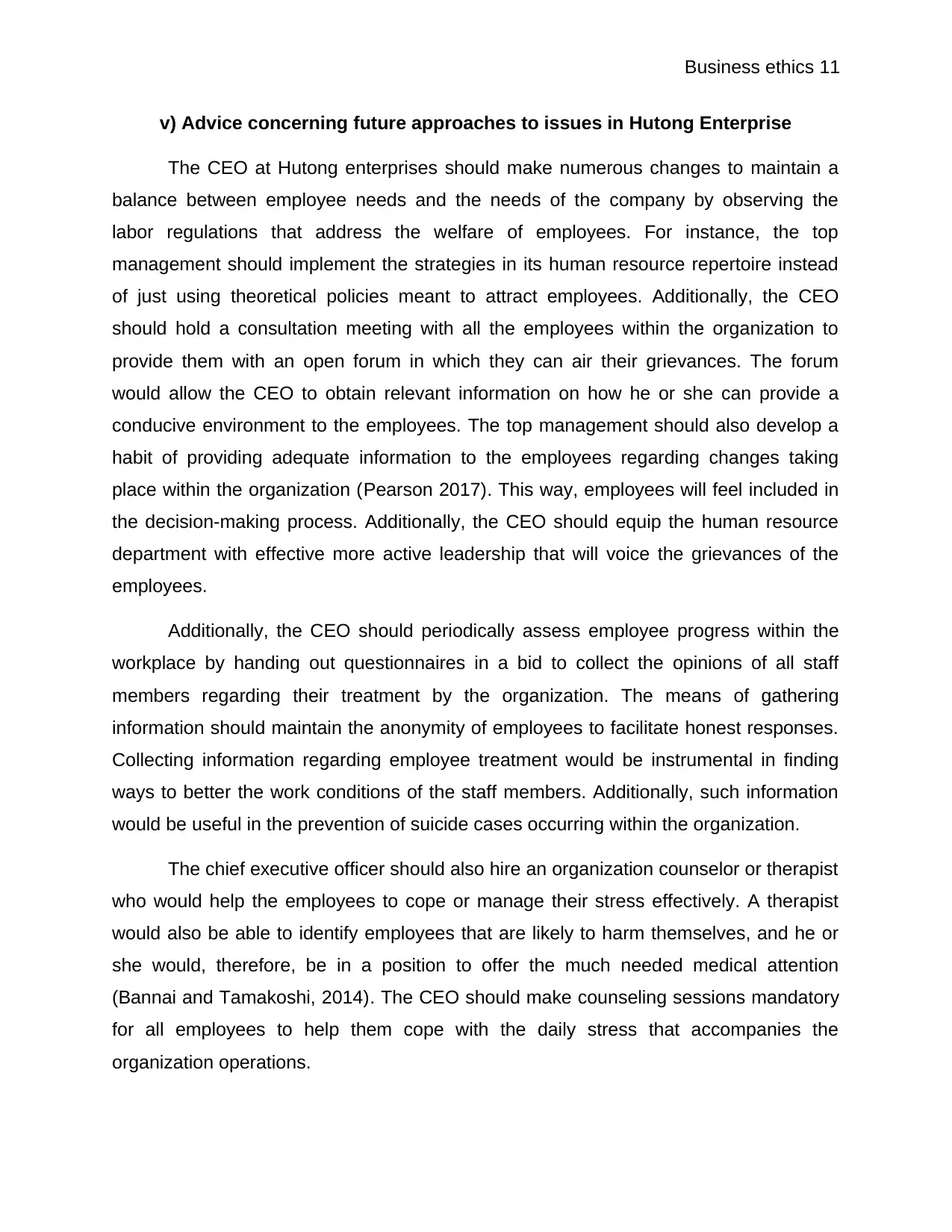
Business ethics 11
v) Advice concerning future approaches to issues in Hutong Enterprise
The CEO at Hutong enterprises should make numerous changes to maintain a
balance between employee needs and the needs of the company by observing the
labor regulations that address the welfare of employees. For instance, the top
management should implement the strategies in its human resource repertoire instead
of just using theoretical policies meant to attract employees. Additionally, the CEO
should hold a consultation meeting with all the employees within the organization to
provide them with an open forum in which they can air their grievances. The forum
would allow the CEO to obtain relevant information on how he or she can provide a
conducive environment to the employees. The top management should also develop a
habit of providing adequate information to the employees regarding changes taking
place within the organization (Pearson 2017). This way, employees will feel included in
the decision-making process. Additionally, the CEO should equip the human resource
department with effective more active leadership that will voice the grievances of the
employees.
Additionally, the CEO should periodically assess employee progress within the
workplace by handing out questionnaires in a bid to collect the opinions of all staff
members regarding their treatment by the organization. The means of gathering
information should maintain the anonymity of employees to facilitate honest responses.
Collecting information regarding employee treatment would be instrumental in finding
ways to better the work conditions of the staff members. Additionally, such information
would be useful in the prevention of suicide cases occurring within the organization.
The chief executive officer should also hire an organization counselor or therapist
who would help the employees to cope or manage their stress effectively. A therapist
would also be able to identify employees that are likely to harm themselves, and he or
she would, therefore, be in a position to offer the much needed medical attention
(Bannai and Tamakoshi, 2014). The CEO should make counseling sessions mandatory
for all employees to help them cope with the daily stress that accompanies the
organization operations.
v) Advice concerning future approaches to issues in Hutong Enterprise
The CEO at Hutong enterprises should make numerous changes to maintain a
balance between employee needs and the needs of the company by observing the
labor regulations that address the welfare of employees. For instance, the top
management should implement the strategies in its human resource repertoire instead
of just using theoretical policies meant to attract employees. Additionally, the CEO
should hold a consultation meeting with all the employees within the organization to
provide them with an open forum in which they can air their grievances. The forum
would allow the CEO to obtain relevant information on how he or she can provide a
conducive environment to the employees. The top management should also develop a
habit of providing adequate information to the employees regarding changes taking
place within the organization (Pearson 2017). This way, employees will feel included in
the decision-making process. Additionally, the CEO should equip the human resource
department with effective more active leadership that will voice the grievances of the
employees.
Additionally, the CEO should periodically assess employee progress within the
workplace by handing out questionnaires in a bid to collect the opinions of all staff
members regarding their treatment by the organization. The means of gathering
information should maintain the anonymity of employees to facilitate honest responses.
Collecting information regarding employee treatment would be instrumental in finding
ways to better the work conditions of the staff members. Additionally, such information
would be useful in the prevention of suicide cases occurring within the organization.
The chief executive officer should also hire an organization counselor or therapist
who would help the employees to cope or manage their stress effectively. A therapist
would also be able to identify employees that are likely to harm themselves, and he or
she would, therefore, be in a position to offer the much needed medical attention
(Bannai and Tamakoshi, 2014). The CEO should make counseling sessions mandatory
for all employees to help them cope with the daily stress that accompanies the
organization operations.
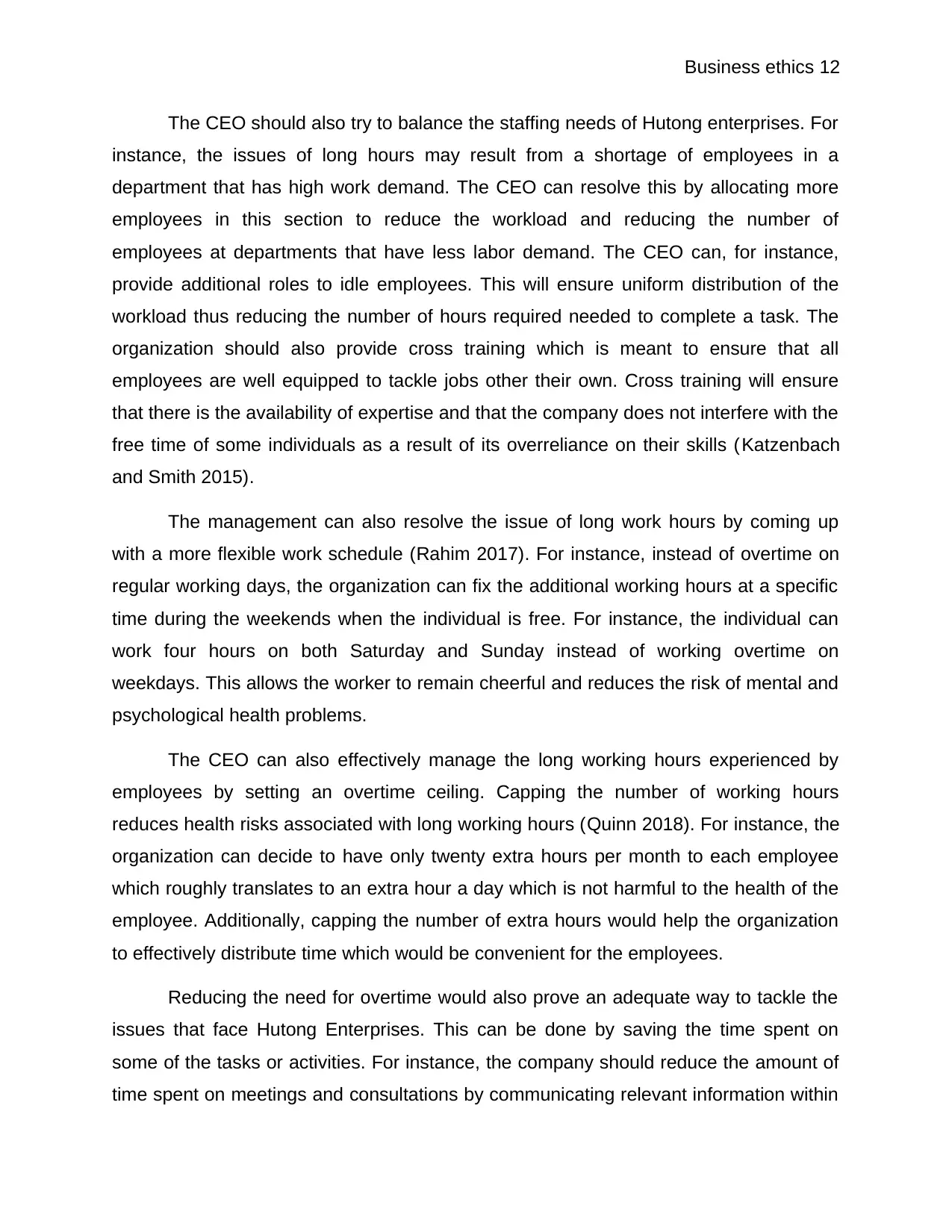
Business ethics 12
The CEO should also try to balance the staffing needs of Hutong enterprises. For
instance, the issues of long hours may result from a shortage of employees in a
department that has high work demand. The CEO can resolve this by allocating more
employees in this section to reduce the workload and reducing the number of
employees at departments that have less labor demand. The CEO can, for instance,
provide additional roles to idle employees. This will ensure uniform distribution of the
workload thus reducing the number of hours required needed to complete a task. The
organization should also provide cross training which is meant to ensure that all
employees are well equipped to tackle jobs other their own. Cross training will ensure
that there is the availability of expertise and that the company does not interfere with the
free time of some individuals as a result of its overreliance on their skills (Katzenbach
and Smith 2015).
The management can also resolve the issue of long work hours by coming up
with a more flexible work schedule (Rahim 2017). For instance, instead of overtime on
regular working days, the organization can fix the additional working hours at a specific
time during the weekends when the individual is free. For instance, the individual can
work four hours on both Saturday and Sunday instead of working overtime on
weekdays. This allows the worker to remain cheerful and reduces the risk of mental and
psychological health problems.
The CEO can also effectively manage the long working hours experienced by
employees by setting an overtime ceiling. Capping the number of working hours
reduces health risks associated with long working hours (Quinn 2018). For instance, the
organization can decide to have only twenty extra hours per month to each employee
which roughly translates to an extra hour a day which is not harmful to the health of the
employee. Additionally, capping the number of extra hours would help the organization
to effectively distribute time which would be convenient for the employees.
Reducing the need for overtime would also prove an adequate way to tackle the
issues that face Hutong Enterprises. This can be done by saving the time spent on
some of the tasks or activities. For instance, the company should reduce the amount of
time spent on meetings and consultations by communicating relevant information within
The CEO should also try to balance the staffing needs of Hutong enterprises. For
instance, the issues of long hours may result from a shortage of employees in a
department that has high work demand. The CEO can resolve this by allocating more
employees in this section to reduce the workload and reducing the number of
employees at departments that have less labor demand. The CEO can, for instance,
provide additional roles to idle employees. This will ensure uniform distribution of the
workload thus reducing the number of hours required needed to complete a task. The
organization should also provide cross training which is meant to ensure that all
employees are well equipped to tackle jobs other their own. Cross training will ensure
that there is the availability of expertise and that the company does not interfere with the
free time of some individuals as a result of its overreliance on their skills (Katzenbach
and Smith 2015).
The management can also resolve the issue of long work hours by coming up
with a more flexible work schedule (Rahim 2017). For instance, instead of overtime on
regular working days, the organization can fix the additional working hours at a specific
time during the weekends when the individual is free. For instance, the individual can
work four hours on both Saturday and Sunday instead of working overtime on
weekdays. This allows the worker to remain cheerful and reduces the risk of mental and
psychological health problems.
The CEO can also effectively manage the long working hours experienced by
employees by setting an overtime ceiling. Capping the number of working hours
reduces health risks associated with long working hours (Quinn 2018). For instance, the
organization can decide to have only twenty extra hours per month to each employee
which roughly translates to an extra hour a day which is not harmful to the health of the
employee. Additionally, capping the number of extra hours would help the organization
to effectively distribute time which would be convenient for the employees.
Reducing the need for overtime would also prove an adequate way to tackle the
issues that face Hutong Enterprises. This can be done by saving the time spent on
some of the tasks or activities. For instance, the company should reduce the amount of
time spent on meetings and consultations by communicating relevant information within
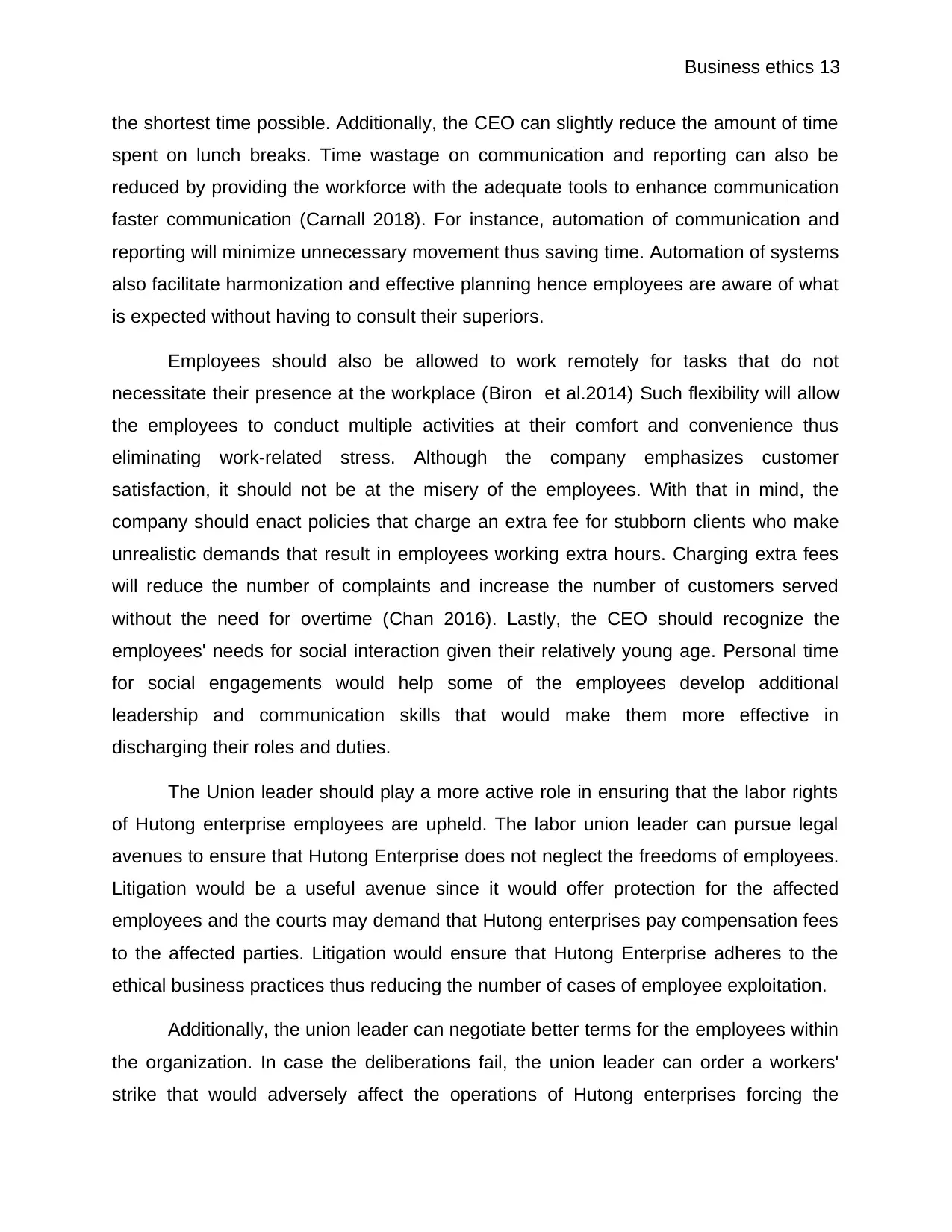
Business ethics 13
the shortest time possible. Additionally, the CEO can slightly reduce the amount of time
spent on lunch breaks. Time wastage on communication and reporting can also be
reduced by providing the workforce with the adequate tools to enhance communication
faster communication (Carnall 2018). For instance, automation of communication and
reporting will minimize unnecessary movement thus saving time. Automation of systems
also facilitate harmonization and effective planning hence employees are aware of what
is expected without having to consult their superiors.
Employees should also be allowed to work remotely for tasks that do not
necessitate their presence at the workplace (Biron et al.2014) Such flexibility will allow
the employees to conduct multiple activities at their comfort and convenience thus
eliminating work-related stress. Although the company emphasizes customer
satisfaction, it should not be at the misery of the employees. With that in mind, the
company should enact policies that charge an extra fee for stubborn clients who make
unrealistic demands that result in employees working extra hours. Charging extra fees
will reduce the number of complaints and increase the number of customers served
without the need for overtime (Chan 2016). Lastly, the CEO should recognize the
employees' needs for social interaction given their relatively young age. Personal time
for social engagements would help some of the employees develop additional
leadership and communication skills that would make them more effective in
discharging their roles and duties.
The Union leader should play a more active role in ensuring that the labor rights
of Hutong enterprise employees are upheld. The labor union leader can pursue legal
avenues to ensure that Hutong Enterprise does not neglect the freedoms of employees.
Litigation would be a useful avenue since it would offer protection for the affected
employees and the courts may demand that Hutong enterprises pay compensation fees
to the affected parties. Litigation would ensure that Hutong Enterprise adheres to the
ethical business practices thus reducing the number of cases of employee exploitation.
Additionally, the union leader can negotiate better terms for the employees within
the organization. In case the deliberations fail, the union leader can order a workers'
strike that would adversely affect the operations of Hutong enterprises forcing the
the shortest time possible. Additionally, the CEO can slightly reduce the amount of time
spent on lunch breaks. Time wastage on communication and reporting can also be
reduced by providing the workforce with the adequate tools to enhance communication
faster communication (Carnall 2018). For instance, automation of communication and
reporting will minimize unnecessary movement thus saving time. Automation of systems
also facilitate harmonization and effective planning hence employees are aware of what
is expected without having to consult their superiors.
Employees should also be allowed to work remotely for tasks that do not
necessitate their presence at the workplace (Biron et al.2014) Such flexibility will allow
the employees to conduct multiple activities at their comfort and convenience thus
eliminating work-related stress. Although the company emphasizes customer
satisfaction, it should not be at the misery of the employees. With that in mind, the
company should enact policies that charge an extra fee for stubborn clients who make
unrealistic demands that result in employees working extra hours. Charging extra fees
will reduce the number of complaints and increase the number of customers served
without the need for overtime (Chan 2016). Lastly, the CEO should recognize the
employees' needs for social interaction given their relatively young age. Personal time
for social engagements would help some of the employees develop additional
leadership and communication skills that would make them more effective in
discharging their roles and duties.
The Union leader should play a more active role in ensuring that the labor rights
of Hutong enterprise employees are upheld. The labor union leader can pursue legal
avenues to ensure that Hutong Enterprise does not neglect the freedoms of employees.
Litigation would be a useful avenue since it would offer protection for the affected
employees and the courts may demand that Hutong enterprises pay compensation fees
to the affected parties. Litigation would ensure that Hutong Enterprise adheres to the
ethical business practices thus reducing the number of cases of employee exploitation.
Additionally, the union leader can negotiate better terms for the employees within
the organization. In case the deliberations fail, the union leader can order a workers'
strike that would adversely affect the operations of Hutong enterprises forcing the
Paraphrase This Document
Need a fresh take? Get an instant paraphrase of this document with our AI Paraphraser

Business ethics 14
organization to reconsider its options. The union leader should also seek answers
regarding the series of suicides taking place within the Organization to force the
organization to take quick measures to prevent similar occurrences in the future. The
union leader should also create awareness of employee rights and the proper channels
that the staff members ought to follow when the employer violates their rights. The
union leader also ought to keep both the staff members and the employer of changes in
rules and regulations affecting workers’ rights. Providing such information to the
organizations and the staff members will ensure that the organization is well informed
on the legality of the decisions it is about to make. The union leader should also give
priority the workplace health and safety of its members by ensuring that the employer
only acts in the best interests of the employees.
Analysis
Actions such as cross training, flexible schedules, freedom to work remotely and
job sharing can be useful in reducing stress or depression resulting from long working
hours (Shanafelt, and Noseworthy 2017). Providing counseling services and reviewing
the workplace culture are also ways other effective ways of managing the mental health
of employees within the organization. The union leader also has an important role to
play in ensuring that the rights of workers are not violated by the employer. Union
leaders can protect the employees through legal means such as litigation and labor
unrests.
organization to reconsider its options. The union leader should also seek answers
regarding the series of suicides taking place within the Organization to force the
organization to take quick measures to prevent similar occurrences in the future. The
union leader should also create awareness of employee rights and the proper channels
that the staff members ought to follow when the employer violates their rights. The
union leader also ought to keep both the staff members and the employer of changes in
rules and regulations affecting workers’ rights. Providing such information to the
organizations and the staff members will ensure that the organization is well informed
on the legality of the decisions it is about to make. The union leader should also give
priority the workplace health and safety of its members by ensuring that the employer
only acts in the best interests of the employees.
Analysis
Actions such as cross training, flexible schedules, freedom to work remotely and
job sharing can be useful in reducing stress or depression resulting from long working
hours (Shanafelt, and Noseworthy 2017). Providing counseling services and reviewing
the workplace culture are also ways other effective ways of managing the mental health
of employees within the organization. The union leader also has an important role to
play in ensuring that the rights of workers are not violated by the employer. Union
leaders can protect the employees through legal means such as litigation and labor
unrests.
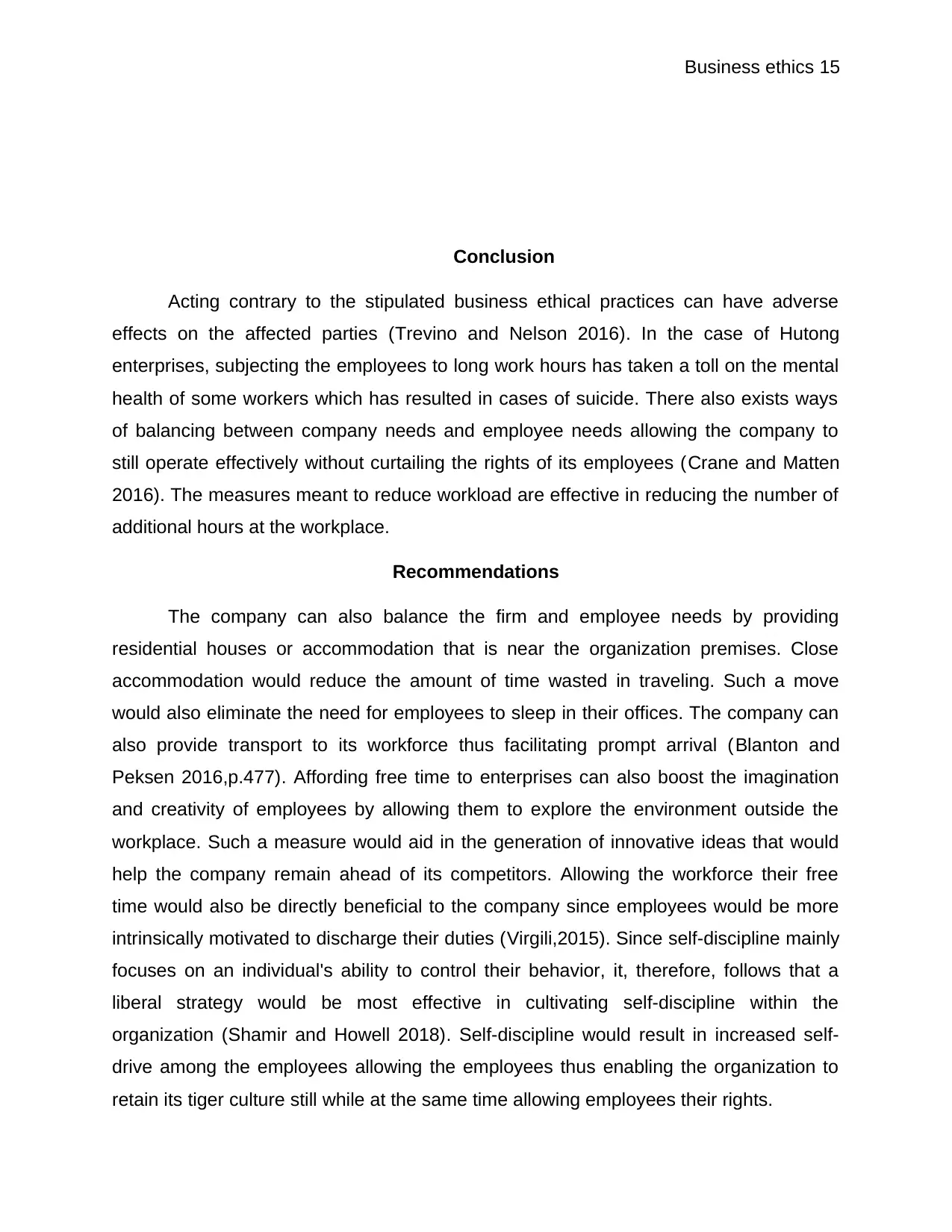
Business ethics 15
Conclusion
Acting contrary to the stipulated business ethical practices can have adverse
effects on the affected parties (Trevino and Nelson 2016). In the case of Hutong
enterprises, subjecting the employees to long work hours has taken a toll on the mental
health of some workers which has resulted in cases of suicide. There also exists ways
of balancing between company needs and employee needs allowing the company to
still operate effectively without curtailing the rights of its employees (Crane and Matten
2016). The measures meant to reduce workload are effective in reducing the number of
additional hours at the workplace.
Recommendations
The company can also balance the firm and employee needs by providing
residential houses or accommodation that is near the organization premises. Close
accommodation would reduce the amount of time wasted in traveling. Such a move
would also eliminate the need for employees to sleep in their offices. The company can
also provide transport to its workforce thus facilitating prompt arrival (Blanton and
Peksen 2016,p.477). Affording free time to enterprises can also boost the imagination
and creativity of employees by allowing them to explore the environment outside the
workplace. Such a measure would aid in the generation of innovative ideas that would
help the company remain ahead of its competitors. Allowing the workforce their free
time would also be directly beneficial to the company since employees would be more
intrinsically motivated to discharge their duties (Virgili,2015). Since self-discipline mainly
focuses on an individual's ability to control their behavior, it, therefore, follows that a
liberal strategy would be most effective in cultivating self-discipline within the
organization (Shamir and Howell 2018). Self-discipline would result in increased self-
drive among the employees allowing the employees thus enabling the organization to
retain its tiger culture still while at the same time allowing employees their rights.
Conclusion
Acting contrary to the stipulated business ethical practices can have adverse
effects on the affected parties (Trevino and Nelson 2016). In the case of Hutong
enterprises, subjecting the employees to long work hours has taken a toll on the mental
health of some workers which has resulted in cases of suicide. There also exists ways
of balancing between company needs and employee needs allowing the company to
still operate effectively without curtailing the rights of its employees (Crane and Matten
2016). The measures meant to reduce workload are effective in reducing the number of
additional hours at the workplace.
Recommendations
The company can also balance the firm and employee needs by providing
residential houses or accommodation that is near the organization premises. Close
accommodation would reduce the amount of time wasted in traveling. Such a move
would also eliminate the need for employees to sleep in their offices. The company can
also provide transport to its workforce thus facilitating prompt arrival (Blanton and
Peksen 2016,p.477). Affording free time to enterprises can also boost the imagination
and creativity of employees by allowing them to explore the environment outside the
workplace. Such a measure would aid in the generation of innovative ideas that would
help the company remain ahead of its competitors. Allowing the workforce their free
time would also be directly beneficial to the company since employees would be more
intrinsically motivated to discharge their duties (Virgili,2015). Since self-discipline mainly
focuses on an individual's ability to control their behavior, it, therefore, follows that a
liberal strategy would be most effective in cultivating self-discipline within the
organization (Shamir and Howell 2018). Self-discipline would result in increased self-
drive among the employees allowing the employees thus enabling the organization to
retain its tiger culture still while at the same time allowing employees their rights.
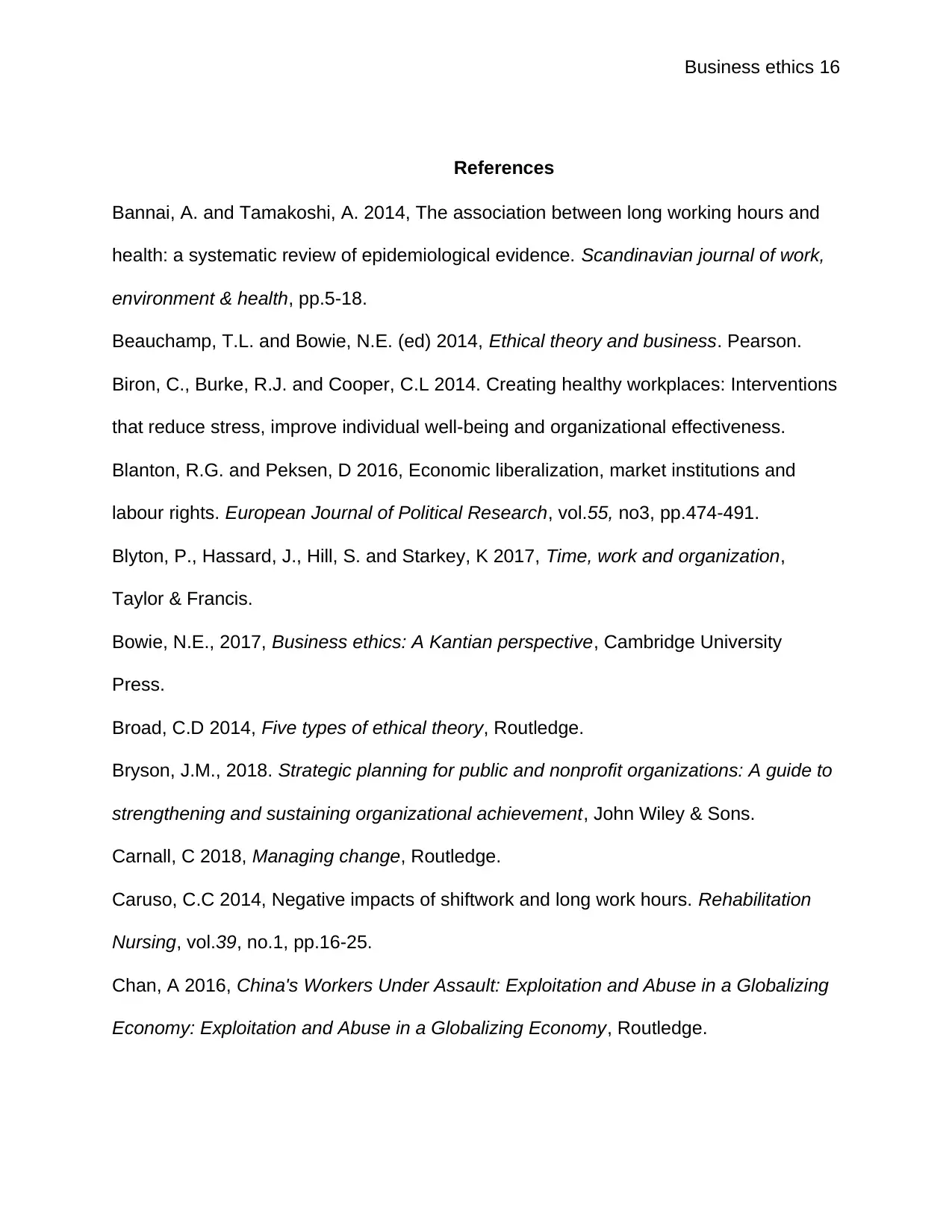
Business ethics 16
References
Bannai, A. and Tamakoshi, A. 2014, The association between long working hours and
health: a systematic review of epidemiological evidence. Scandinavian journal of work,
environment & health, pp.5-18.
Beauchamp, T.L. and Bowie, N.E. (ed) 2014, Ethical theory and business. Pearson.
Biron, C., Burke, R.J. and Cooper, C.L 2014. Creating healthy workplaces: Interventions
that reduce stress, improve individual well-being and organizational effectiveness.
Blanton, R.G. and Peksen, D 2016, Economic liberalization, market institutions and
labour rights. European Journal of Political Research, vol.55, no3, pp.474-491.
Blyton, P., Hassard, J., Hill, S. and Starkey, K 2017, Time, work and organization,
Taylor & Francis.
Bowie, N.E., 2017, Business ethics: A Kantian perspective, Cambridge University
Press.
Broad, C.D 2014, Five types of ethical theory, Routledge.
Bryson, J.M., 2018. Strategic planning for public and nonprofit organizations: A guide to
strengthening and sustaining organizational achievement, John Wiley & Sons.
Carnall, C 2018, Managing change, Routledge.
Caruso, C.C 2014, Negative impacts of shiftwork and long work hours. Rehabilitation
Nursing, vol.39, no.1, pp.16-25.
Chan, A 2016, China's Workers Under Assault: Exploitation and Abuse in a Globalizing
Economy: Exploitation and Abuse in a Globalizing Economy, Routledge.
References
Bannai, A. and Tamakoshi, A. 2014, The association between long working hours and
health: a systematic review of epidemiological evidence. Scandinavian journal of work,
environment & health, pp.5-18.
Beauchamp, T.L. and Bowie, N.E. (ed) 2014, Ethical theory and business. Pearson.
Biron, C., Burke, R.J. and Cooper, C.L 2014. Creating healthy workplaces: Interventions
that reduce stress, improve individual well-being and organizational effectiveness.
Blanton, R.G. and Peksen, D 2016, Economic liberalization, market institutions and
labour rights. European Journal of Political Research, vol.55, no3, pp.474-491.
Blyton, P., Hassard, J., Hill, S. and Starkey, K 2017, Time, work and organization,
Taylor & Francis.
Bowie, N.E., 2017, Business ethics: A Kantian perspective, Cambridge University
Press.
Broad, C.D 2014, Five types of ethical theory, Routledge.
Bryson, J.M., 2018. Strategic planning for public and nonprofit organizations: A guide to
strengthening and sustaining organizational achievement, John Wiley & Sons.
Carnall, C 2018, Managing change, Routledge.
Caruso, C.C 2014, Negative impacts of shiftwork and long work hours. Rehabilitation
Nursing, vol.39, no.1, pp.16-25.
Chan, A 2016, China's Workers Under Assault: Exploitation and Abuse in a Globalizing
Economy: Exploitation and Abuse in a Globalizing Economy, Routledge.
Secure Best Marks with AI Grader
Need help grading? Try our AI Grader for instant feedback on your assignments.
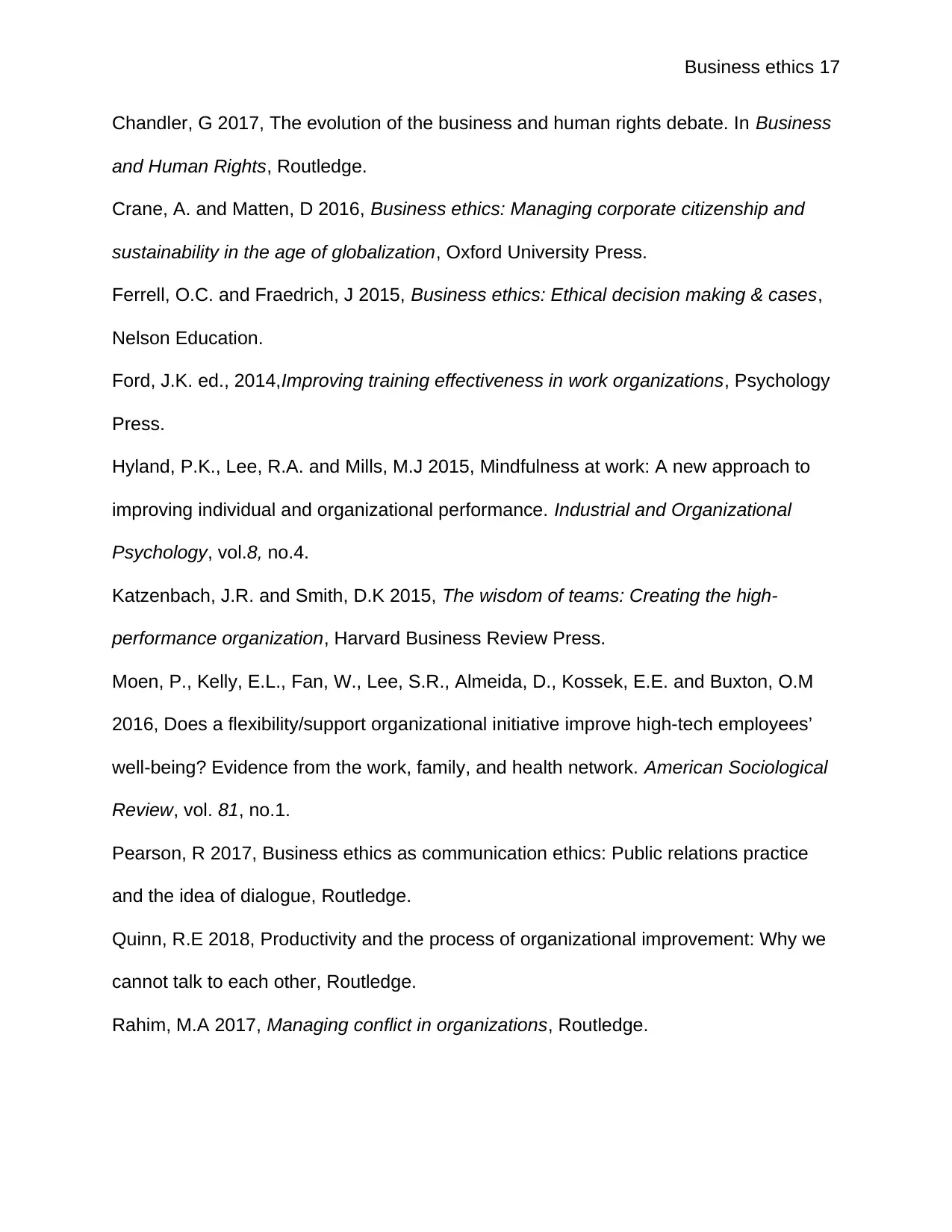
Business ethics 17
Chandler, G 2017, The evolution of the business and human rights debate. In Business
and Human Rights, Routledge.
Crane, A. and Matten, D 2016, Business ethics: Managing corporate citizenship and
sustainability in the age of globalization, Oxford University Press.
Ferrell, O.C. and Fraedrich, J 2015, Business ethics: Ethical decision making & cases,
Nelson Education.
Ford, J.K. ed., 2014,Improving training effectiveness in work organizations, Psychology
Press.
Hyland, P.K., Lee, R.A. and Mills, M.J 2015, Mindfulness at work: A new approach to
improving individual and organizational performance. Industrial and Organizational
Psychology, vol.8, no.4.
Katzenbach, J.R. and Smith, D.K 2015, The wisdom of teams: Creating the high-
performance organization, Harvard Business Review Press.
Moen, P., Kelly, E.L., Fan, W., Lee, S.R., Almeida, D., Kossek, E.E. and Buxton, O.M
2016, Does a flexibility/support organizational initiative improve high-tech employees’
well-being? Evidence from the work, family, and health network. American Sociological
Review, vol. 81, no.1.
Pearson, R 2017, Business ethics as communication ethics: Public relations practice
and the idea of dialogue, Routledge.
Quinn, R.E 2018, Productivity and the process of organizational improvement: Why we
cannot talk to each other, Routledge.
Rahim, M.A 2017, Managing conflict in organizations, Routledge.
Chandler, G 2017, The evolution of the business and human rights debate. In Business
and Human Rights, Routledge.
Crane, A. and Matten, D 2016, Business ethics: Managing corporate citizenship and
sustainability in the age of globalization, Oxford University Press.
Ferrell, O.C. and Fraedrich, J 2015, Business ethics: Ethical decision making & cases,
Nelson Education.
Ford, J.K. ed., 2014,Improving training effectiveness in work organizations, Psychology
Press.
Hyland, P.K., Lee, R.A. and Mills, M.J 2015, Mindfulness at work: A new approach to
improving individual and organizational performance. Industrial and Organizational
Psychology, vol.8, no.4.
Katzenbach, J.R. and Smith, D.K 2015, The wisdom of teams: Creating the high-
performance organization, Harvard Business Review Press.
Moen, P., Kelly, E.L., Fan, W., Lee, S.R., Almeida, D., Kossek, E.E. and Buxton, O.M
2016, Does a flexibility/support organizational initiative improve high-tech employees’
well-being? Evidence from the work, family, and health network. American Sociological
Review, vol. 81, no.1.
Pearson, R 2017, Business ethics as communication ethics: Public relations practice
and the idea of dialogue, Routledge.
Quinn, R.E 2018, Productivity and the process of organizational improvement: Why we
cannot talk to each other, Routledge.
Rahim, M.A 2017, Managing conflict in organizations, Routledge.

Business ethics 18
Shamir, B. and Howell, J.M 2018, Organizational and contextual influences on the
emergence and effectiveness of charismatic leadership, Emerald Publishing Limited.
Shanafelt, T.D. and Noseworthy, J.H 2017, Executive leadership and physician well-
being: nine organizational strategies to promote engagement and reduce burnout,
Elsevier.
Timms, C., Brough, P., O'Driscoll, M., Kalliath, T., Siu, O.L., Sit, C. and Lo, D 2015,
Flexible work arrangements, work engagement, turnover intentions and psychological
health. Taylor &Francis
Trevino, L.K. and Nelson, K.A 2016, Managing business ethics: Straight talk about how
to do it right, John Wiley & Sons.
Virgili, M 2015, Mindfulness-based interventions reduce psychological distress in
working adults: a meta-analysis of intervention studies, Taylor &Francis
Wang, Z 2017, Economic Competition, Policy Interdependence, and Labour Rights.
New Political Economy, John Wiley
Weiss, J.W 2014, Business ethics: A stakeholder and issues management approach,
Berrett-Koehler Publishers.
Shamir, B. and Howell, J.M 2018, Organizational and contextual influences on the
emergence and effectiveness of charismatic leadership, Emerald Publishing Limited.
Shanafelt, T.D. and Noseworthy, J.H 2017, Executive leadership and physician well-
being: nine organizational strategies to promote engagement and reduce burnout,
Elsevier.
Timms, C., Brough, P., O'Driscoll, M., Kalliath, T., Siu, O.L., Sit, C. and Lo, D 2015,
Flexible work arrangements, work engagement, turnover intentions and psychological
health. Taylor &Francis
Trevino, L.K. and Nelson, K.A 2016, Managing business ethics: Straight talk about how
to do it right, John Wiley & Sons.
Virgili, M 2015, Mindfulness-based interventions reduce psychological distress in
working adults: a meta-analysis of intervention studies, Taylor &Francis
Wang, Z 2017, Economic Competition, Policy Interdependence, and Labour Rights.
New Political Economy, John Wiley
Weiss, J.W 2014, Business ethics: A stakeholder and issues management approach,
Berrett-Koehler Publishers.
1 out of 18
Related Documents
Your All-in-One AI-Powered Toolkit for Academic Success.
+13062052269
info@desklib.com
Available 24*7 on WhatsApp / Email
![[object Object]](/_next/static/media/star-bottom.7253800d.svg)
Unlock your academic potential
© 2024 | Zucol Services PVT LTD | All rights reserved.




